Gigi Sciutto was a famous Genovese photographer in the early 1900s. He supposedly shot the first film footage of Genova around 1897. His brother Carlo continued the family's photo studio for 40 years, until his death in 1950. Between 1895 and 1910 the brothers made countless portraits of the famous stage actors of Italy at the time.
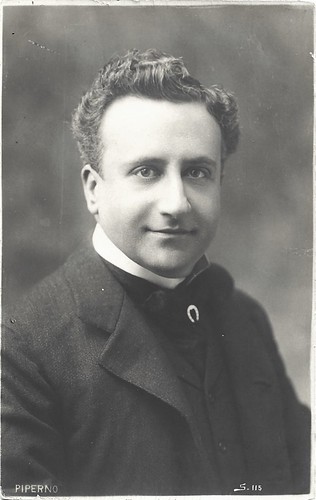
Italian postcard, no. 45. Photo: Sciutto.
Ugo Piperno (1862-1922) was a renowned Italian stage actor and director, who from 1914 also played several parts in Italian silent cinema for Roman film companies such as Cines, Caesar, and Tiber Film.

Italian postcard, no. 51. Photo Sciutto, Genoa.

Italian postcard, no. 58. Photo: Sciutto.
Mercedes Brignone (1885-1967) was an Italian theatre, film, and television actress. The peak of her career was during the silent era. Brignone was directed several times on-screen by her brother, Guido Brignone.
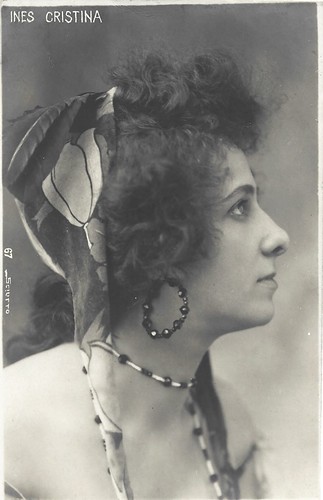
Italian postcard, no. 67. Photo: Sciutto, Genoa.
Ines Cristina (1875-1955) was an Italian stage and screen actress, who was married to acclaimed stage actor and director Ermete Zacconi.
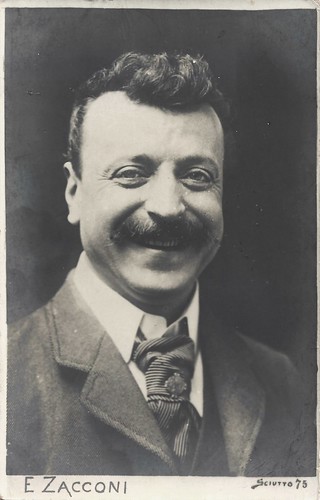
Italian postcard, no. 75. Photo: Sciutto.

Italian postcard, no. 76. Photo: Sciutto.
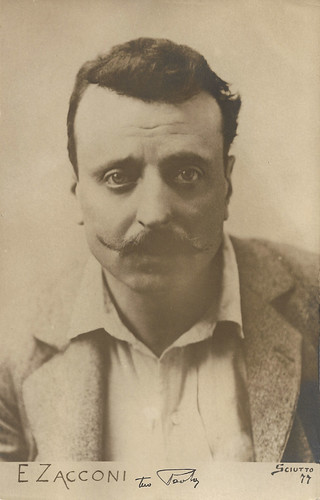
Italian postcard, no. 77. Photo: Sciutto.
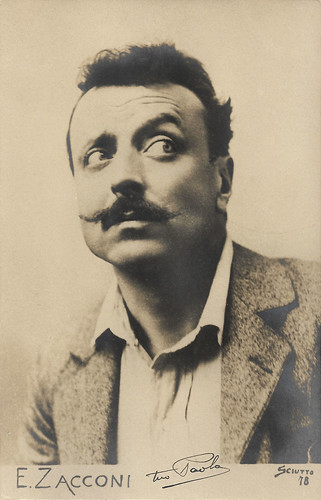
Italian postcard, no. 78. Photo: Sciutto.
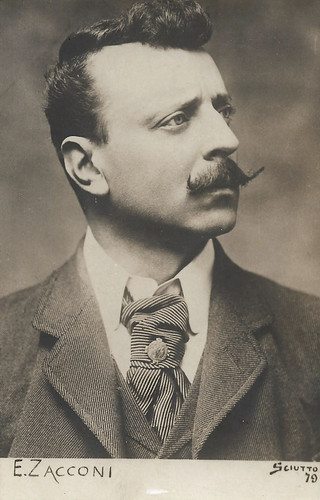
Italian postcard, no. 79. Photo: Sciutto.
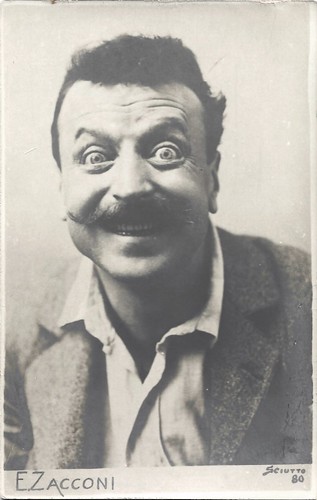
Italian postcard, no. 80. Photo: Sciutto.
Ermete Zacconi (1857-1948) was a monstre sacré of the Italian theatre, He also acted in various Italian silent and sound films.

Italian postcard, no. 86. Photo: Sciutto. Sent by mail in 1912.
Leopoldo Fregoli (1867-1936) was one of the first vaudeville actors who used film in his acts. Fregoli was famous for his rapid transformation acts and his impersonations of famous artistic and political characters. In 1898 he bought a cinematograph from the Lumière brothers and started to show shorts, named Fregoligraph, as part of his stage act. They were recordings of his transformation acts.
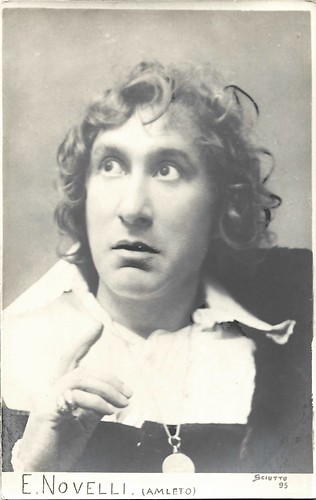
Italian postcard, no. 95. Photo: Sciutto, Genoa. Ermete Novelli as Hamlet.
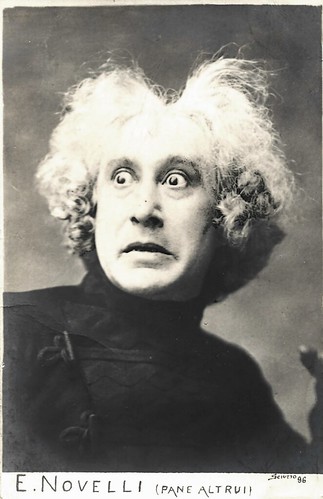
Italian postcard, no. 96. Photo: Sciutto, Genoa. Ermete Novelli in the play 'Pane altrui' (Fortune's Fool) by Ivan Turgenev.
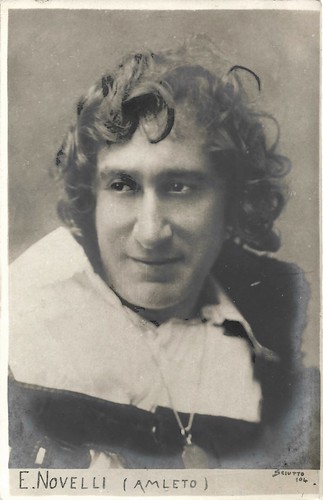
Italian postcard, no. 104. Photo: Sciutto, Genoa. Ermete Novelli as Hamlet.
Italian actor Ermete Novelli (1851-1919) was a legendary monstre sacré of the theatre. In the 1910s he appeared in films by Film d'Arte Italiana, Ambrosio and Raggio Film.
The photo studio Sciutto was founded by father Giovanni Battista/Giambattista Sciutto (1817-1877) in 1862, in Genoa, in Palazzo Adorno, Via Garibaldi (then Via Nuova). At his death, his widow Eugenia, and from 1895 his son Gigi (Giambattista, like his father) Sciutto, took over.
In 1885 the studio G.B. Sciutto moved to the piano nobile of the palazzo of the Marchese Balestrino del Carretto in Piazza Fontane Marose 18. In 1900 the company changed its name, becoming Fratelli Sciutto. At the death of mama Eugenia in 1909, the company moved to Palazzo delle Cupole in Via XX Settembre, where the same year the company was taken over by Gigi's brother Carlo Sciutto, who in 1911 became the sole owner.
Gigi began to occupy himself with film, becoming one of the pioneers in the city - his first film experiments date in 1897, and founding his own company in 1908, after which he emigrated to Brazil in 1916. Carlo continued the photo studio for 40 years, until his death in 1950. Meanwhile, the studio moved to Via Maragliano.
While Gigi was looking for portraits with a maximum of detail, Carlo experimented with 'flou effects'. Between 1895 and 1910 the brothers made countless portraits of famous stage actors such as Ermete Zacconi, Emma and Irma Grammatica, Eleonora Duse, Ruggero Ruggeri, etc. Many of their portraits were published in illustrated magazines such as Illustrazione Italiana, in which they also published their outdoor photography such as visits by the Italian Royal family, the Italian Navy, and visits of writer Edmondo de Amicis.
With his new style of photo portraiture, Gigi Sciutto set the tone and deviated from the small-sized 19th-century photo portraits with their limited aesthetics. This also shows e.g. in a series of photos he made for the staging in Genova in 1901 of Eleonora Duse in 'La città morta' by Gabriele D'Annunzio. He captured her as the blind Anna, who notices her husband Alessandro and a young woman, Bianca Maria, have an affair, but she doesn't really care.

Italian postcard, no. 111. Photo: Sciutto, Genoa.
Flavio Andò (1851-1915) was an Italian theatre actor of great prominence and notoriety in the late 19th and early 20th century. He worked with such stage divas as Eleonora Duse, Tina Di Lorenzo and Irma Gramatica.

Italian postcard, no. 127. Photo: Sciutto, Genova. Eleonora Duse in the play 'La città morta' (The Dead City) by Gabriele D'Annunzio. The photo was made for the performance of Duse in Genoa, Teatro Paganini, in April 1901. The blind Anna holds Bianca Maria onto her lap. She understands that the girl is in love with her own husband Alessandro.

Italian postcard, no. 128. Photo: Sciutto, Genova. Publicity still for the play 'La città morta'. Collection: Didier Hanson.
Eleonora Duse (1858-1924) is considered one of the greatest stage actresses of the 19th and early 20th centuries. Her performances have been considered innovative for the Italian theatre.

Italian postcard, no. 524. Photo: Sciutto, Genova.
Matilde Tescher, known artistically as Tilde Teldi (1878-?), was an Italian theatre and film actress.
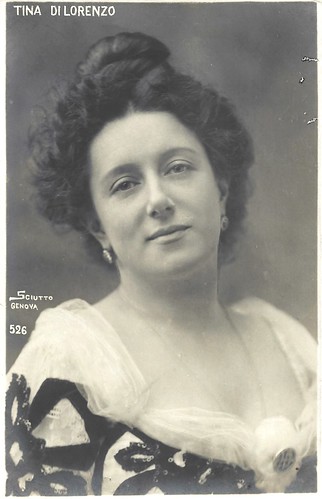
Italian postcard, no. 526. Photo: Sciutto, Genoa.
Tina Di Lorenzo (1872-1930) was one of the 'grandes dames' of the Italian stage during the early twentieth century, nicknamed Angelicata and La encantadora. In 1915 she also acted in two or three films. In 1901 she married reputed stage actor Armando Falconi, who would have a second career in Italian sound cinema.
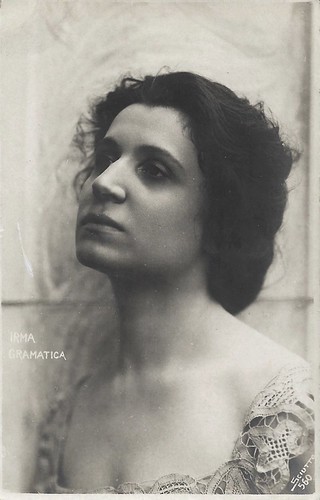
Italian postcard, no. 560. Photo: Sciutto, Genova.
Irma Gramatica (1867-1962) was an Italian stage and screen actress, known for her qualities but also her temper.
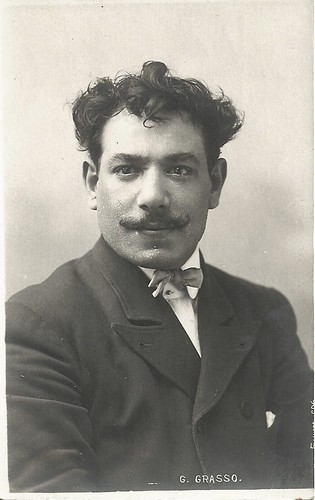
Italian postcard, no. 604. Photo: Sciutto.
Giovanni Grasso (1873-1930) was an Italian stage and screen actor. While he goes as the best Sicilian tragic actor and one of the best in Italy, he also had a limited but important career in Italian silent cinema.

Italian postcard, no. 623. Photo: Sciutto. Possibly for the stage play 'La figlia di Jorio' (Jorio's daughter) by Gabriele D'Annunzio.
Lyda Borelli (1887-1959). La Borelli was already an acclaimed stage actress before she became a star of the Italian silent cinema. The fascinating diva caused a craze among female fans, which was called 'Borellismo'.
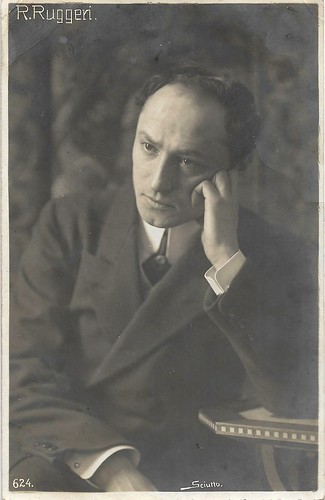
Italian postcard, no. 624. Photo: Sciutto.
Ruggero Ruggeri (1871-1953) was one the most important Italian stage actors of the first half of the twentieth century, who often performed the plays by Luigi Pirandello. He did perform in films too, both in silent and sound films. Nowadays, he is best remembered as the voice of Jesus in the Don Camillo films.

Italian postcard by NPG, no. 643. Photo: Sciutto.
Italia Vitaliani (1866-1938) was an Italian stage and screen actress and artistic director.

Italian postcard, no. 655. Photo: Sciutto, Genoa.
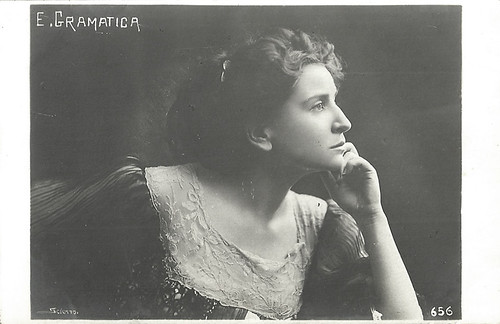
Italian postcard, no. 656. Photo: Sciutto, Genova.
Emma Gramatica (1874-1965) was not only a ‘monstre sacré’ of the Italian stage but also played many old ladies in Italian sound cinema from the 1930s to the 1950s.

Italian postcard. Photo by Sciutto.
Totò Majorana (1874–1944) was an Italian stage and screen actor. He was a member of the major dialectical theatre companies in Sicily in the late 19th and early 20th centuries. With Giovanni Grasso, he had an artistic bond and they went on long tours from 1910-1911. While in London, both were successful in William Shakespeare's 'Othello', with Grasso playing Othello and Majorana Jago. Majorana debuted as a film actor with the Turinese company Savoia in 1913, in various films with Maria Jacobini and Dillo Lombardi. In 1914 he went to Rome to act at Morgana Films and played opposite Giovanni Grasso in two famous lost films in a realist style, Capitan Blanco (1914) and Sperduti nel buio (1914), both by Nino Martoglio. After WWI, Majorana returned to films by Cines, acting in a large string of films often starring Nerio Bernardi and directed by Mario Caserini in 1920-1923.
Source: Marianna Zannoni (Il Teatro in Fotografia. L'immagine della prima attrice Italiana fra otto e novecento - Italian).

Italian postcard, no. 45. Photo: Sciutto.
Ugo Piperno (1862-1922) was a renowned Italian stage actor and director, who from 1914 also played several parts in Italian silent cinema for Roman film companies such as Cines, Caesar, and Tiber Film.

Italian postcard, no. 51. Photo Sciutto, Genoa.

Italian postcard, no. 58. Photo: Sciutto.
Mercedes Brignone (1885-1967) was an Italian theatre, film, and television actress. The peak of her career was during the silent era. Brignone was directed several times on-screen by her brother, Guido Brignone.

Italian postcard, no. 67. Photo: Sciutto, Genoa.
Ines Cristina (1875-1955) was an Italian stage and screen actress, who was married to acclaimed stage actor and director Ermete Zacconi.

Italian postcard, no. 75. Photo: Sciutto.

Italian postcard, no. 76. Photo: Sciutto.

Italian postcard, no. 77. Photo: Sciutto.

Italian postcard, no. 78. Photo: Sciutto.

Italian postcard, no. 79. Photo: Sciutto.

Italian postcard, no. 80. Photo: Sciutto.
Ermete Zacconi (1857-1948) was a monstre sacré of the Italian theatre, He also acted in various Italian silent and sound films.

Italian postcard, no. 86. Photo: Sciutto. Sent by mail in 1912.
Leopoldo Fregoli (1867-1936) was one of the first vaudeville actors who used film in his acts. Fregoli was famous for his rapid transformation acts and his impersonations of famous artistic and political characters. In 1898 he bought a cinematograph from the Lumière brothers and started to show shorts, named Fregoligraph, as part of his stage act. They were recordings of his transformation acts.

Italian postcard, no. 95. Photo: Sciutto, Genoa. Ermete Novelli as Hamlet.

Italian postcard, no. 96. Photo: Sciutto, Genoa. Ermete Novelli in the play 'Pane altrui' (Fortune's Fool) by Ivan Turgenev.

Italian postcard, no. 104. Photo: Sciutto, Genoa. Ermete Novelli as Hamlet.
Italian actor Ermete Novelli (1851-1919) was a legendary monstre sacré of the theatre. In the 1910s he appeared in films by Film d'Arte Italiana, Ambrosio and Raggio Film.
A maximum of detail or 'flou effects'
The photo studio Sciutto was founded by father Giovanni Battista/Giambattista Sciutto (1817-1877) in 1862, in Genoa, in Palazzo Adorno, Via Garibaldi (then Via Nuova). At his death, his widow Eugenia, and from 1895 his son Gigi (Giambattista, like his father) Sciutto, took over.
In 1885 the studio G.B. Sciutto moved to the piano nobile of the palazzo of the Marchese Balestrino del Carretto in Piazza Fontane Marose 18. In 1900 the company changed its name, becoming Fratelli Sciutto. At the death of mama Eugenia in 1909, the company moved to Palazzo delle Cupole in Via XX Settembre, where the same year the company was taken over by Gigi's brother Carlo Sciutto, who in 1911 became the sole owner.
Gigi began to occupy himself with film, becoming one of the pioneers in the city - his first film experiments date in 1897, and founding his own company in 1908, after which he emigrated to Brazil in 1916. Carlo continued the photo studio for 40 years, until his death in 1950. Meanwhile, the studio moved to Via Maragliano.
While Gigi was looking for portraits with a maximum of detail, Carlo experimented with 'flou effects'. Between 1895 and 1910 the brothers made countless portraits of famous stage actors such as Ermete Zacconi, Emma and Irma Grammatica, Eleonora Duse, Ruggero Ruggeri, etc. Many of their portraits were published in illustrated magazines such as Illustrazione Italiana, in which they also published their outdoor photography such as visits by the Italian Royal family, the Italian Navy, and visits of writer Edmondo de Amicis.
With his new style of photo portraiture, Gigi Sciutto set the tone and deviated from the small-sized 19th-century photo portraits with their limited aesthetics. This also shows e.g. in a series of photos he made for the staging in Genova in 1901 of Eleonora Duse in 'La città morta' by Gabriele D'Annunzio. He captured her as the blind Anna, who notices her husband Alessandro and a young woman, Bianca Maria, have an affair, but she doesn't really care.

Italian postcard, no. 111. Photo: Sciutto, Genoa.
Flavio Andò (1851-1915) was an Italian theatre actor of great prominence and notoriety in the late 19th and early 20th century. He worked with such stage divas as Eleonora Duse, Tina Di Lorenzo and Irma Gramatica.

Italian postcard, no. 127. Photo: Sciutto, Genova. Eleonora Duse in the play 'La città morta' (The Dead City) by Gabriele D'Annunzio. The photo was made for the performance of Duse in Genoa, Teatro Paganini, in April 1901. The blind Anna holds Bianca Maria onto her lap. She understands that the girl is in love with her own husband Alessandro.

Italian postcard, no. 128. Photo: Sciutto, Genova. Publicity still for the play 'La città morta'. Collection: Didier Hanson.
Eleonora Duse (1858-1924) is considered one of the greatest stage actresses of the 19th and early 20th centuries. Her performances have been considered innovative for the Italian theatre.

Italian postcard, no. 524. Photo: Sciutto, Genova.
Matilde Tescher, known artistically as Tilde Teldi (1878-?), was an Italian theatre and film actress.

Italian postcard, no. 526. Photo: Sciutto, Genoa.
Tina Di Lorenzo (1872-1930) was one of the 'grandes dames' of the Italian stage during the early twentieth century, nicknamed Angelicata and La encantadora. In 1915 she also acted in two or three films. In 1901 she married reputed stage actor Armando Falconi, who would have a second career in Italian sound cinema.

Italian postcard, no. 560. Photo: Sciutto, Genova.
Irma Gramatica (1867-1962) was an Italian stage and screen actress, known for her qualities but also her temper.

Italian postcard, no. 604. Photo: Sciutto.
Giovanni Grasso (1873-1930) was an Italian stage and screen actor. While he goes as the best Sicilian tragic actor and one of the best in Italy, he also had a limited but important career in Italian silent cinema.

Italian postcard, no. 623. Photo: Sciutto. Possibly for the stage play 'La figlia di Jorio' (Jorio's daughter) by Gabriele D'Annunzio.
Lyda Borelli (1887-1959). La Borelli was already an acclaimed stage actress before she became a star of the Italian silent cinema. The fascinating diva caused a craze among female fans, which was called 'Borellismo'.

Italian postcard, no. 624. Photo: Sciutto.
Ruggero Ruggeri (1871-1953) was one the most important Italian stage actors of the first half of the twentieth century, who often performed the plays by Luigi Pirandello. He did perform in films too, both in silent and sound films. Nowadays, he is best remembered as the voice of Jesus in the Don Camillo films.

Italian postcard by NPG, no. 643. Photo: Sciutto.
Italia Vitaliani (1866-1938) was an Italian stage and screen actress and artistic director.

Italian postcard, no. 655. Photo: Sciutto, Genoa.

Italian postcard, no. 656. Photo: Sciutto, Genova.
Emma Gramatica (1874-1965) was not only a ‘monstre sacré’ of the Italian stage but also played many old ladies in Italian sound cinema from the 1930s to the 1950s.

Italian postcard. Photo by Sciutto.
Totò Majorana (1874–1944) was an Italian stage and screen actor. He was a member of the major dialectical theatre companies in Sicily in the late 19th and early 20th centuries. With Giovanni Grasso, he had an artistic bond and they went on long tours from 1910-1911. While in London, both were successful in William Shakespeare's 'Othello', with Grasso playing Othello and Majorana Jago. Majorana debuted as a film actor with the Turinese company Savoia in 1913, in various films with Maria Jacobini and Dillo Lombardi. In 1914 he went to Rome to act at Morgana Films and played opposite Giovanni Grasso in two famous lost films in a realist style, Capitan Blanco (1914) and Sperduti nel buio (1914), both by Nino Martoglio. After WWI, Majorana returned to films by Cines, acting in a large string of films often starring Nerio Bernardi and directed by Mario Caserini in 1920-1923.
Source: Marianna Zannoni (Il Teatro in Fotografia. L'immagine della prima attrice Italiana fra otto e novecento - Italian).
No comments:
Post a Comment